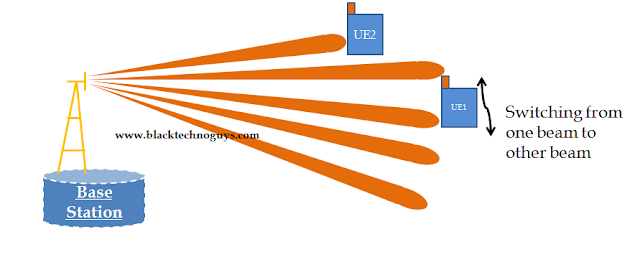beamforming basic part-1
Home LTE NB-IoT 5G(NR-NSA)
More the antenna elements => sharper the beam shape => concentrated energy => Less Interfered => Great Performance
Usually beams are formed by analog beam forming technique, but for the data transmissions 5G system dynamically uses digital or analog or the combination of both (analog and digital) called Hybrid beam forming technique.
In
this article we will learn basics about beam forming and why it is needed.
QUS- What is Beam-Forming and its benefits?
As
the name suggest beam forming is the forming of beam of RF energy.
Fundamentally the electromagnetic wave radiation pattern from a system is
focused like a beam from torch or beam.
It
is a traffic signaling system for cellular base stations that identifies the
most efficient data delivery route to particular user. It also reduces
interference for nearby users in the process.
At
the same time it is used to detect and estimate the signal of spatial filtering
and interference rejection. It will also improve the overall radio environment
of a cell by limiting interference to small fractions of the entire space
around a transmitter and likewise limiting the impact of interference on a
receiver to infrequent stochastic events and thus sometimes referred as beam
shaping.
Beam
forming is an attractive solution for boosting mobile network performance as it
can provide high spectral efficiency which adds a lot more capacity to existing
base station sites.
It
also helps in improving the link performance and provides an extended coverage
area. Beam forming has been known since years but was not supported by LTE
specifications in 3GPP release 15. The benefits of beam forming are obtained in
practice with massive MIMO antennas.
QUS- How Beam-Forming can help massive-MIMO?
Beam
forming can also help massive MIMO arrays that are base stations arrayed with
multiple individual antennas, to make more efficient use of the spectrum around
them.
The
primary challenge for massive MIMO is to reduce interference while transmitting
more data from many more antennas at a time. Hence, beam-forming in massive MIMO
base stations do signal-processing algorithms to plot the best transmission
route through the air to each user which helps the efficiency and helps to
utilize all spectrums deployed into it.
Then
they can send individual data packets in multiple directions, bouncing them off
buildings and other objects in a precisely coordinated pattern. By arranging
the packet movements and arrival time, beam forming allows many users and
antennas on a massive MIMO array to exchange much more information at a time.
QUS- How Beam-Forming can improve efficiency of millimeter-wave?
For
millimeter waves (FR2), beam forming is primarily used to address a different set of
problems. As we know that cellular signals are easily blocked by objects and
tend to weaken over long distances. In this case, beam forming can help by
focusing a signal in a concentrated beam that points only in the direction of a
user, rather than broadcasting in many directions at once. This approach can
strengthen the signal’s chances of arriving intact and reduce interference for
everyone else.
More the antenna elements => sharper the beam shape => concentrated energy => Less Interfered => Great Performance
Usually beams are formed by analog beam forming technique, but for the data transmissions 5G system dynamically uses digital or analog or the combination of both (analog and digital) called Hybrid beam forming technique.
QUS- Can device be connected with multi-beams in release 15?
As
the cell coverage is beams based, a mobile terminal in the 5G cell will sync,
attach and report from a single beam only and has no relation with multi beam. As
stated by 3GPP in Rel.15 "The mobile terminal will only connect to a
single beam, multi-beams connection is not supported".
In
Upcoming Part we will learn more about Beam-forming and its interview question
and its answer. And for more learning please go through our 5G and LTE page.
Stay
tune for more Update…………………
Pinal
Dobariya…






Comments
Post a Comment